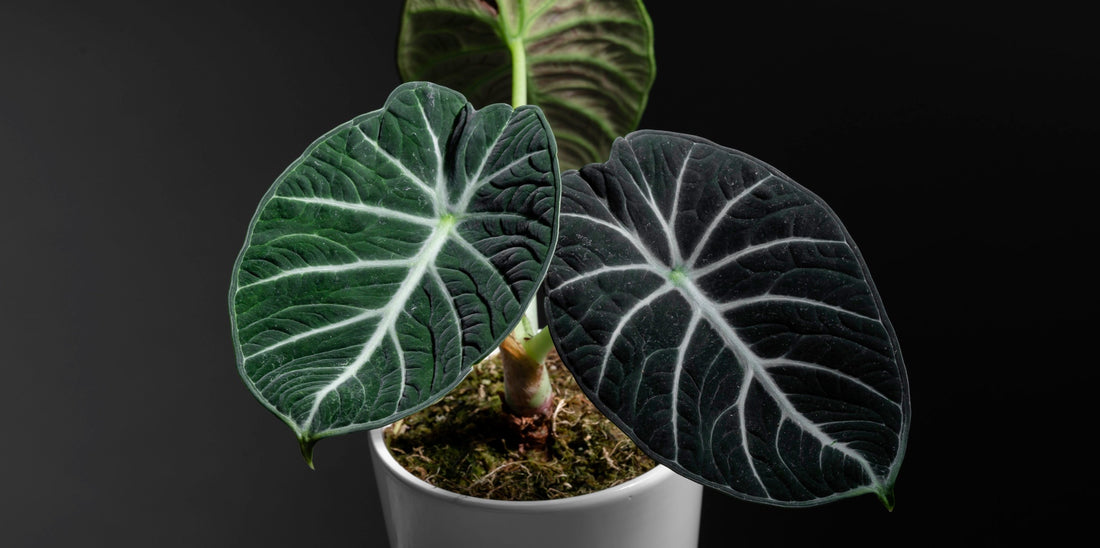If you’re drawn to dramatic foliage and crave a plant with serious statement power, it’s time to meet the Alocasia, the showstopper of your indoor jungle. With arrowhead-shaped leaves, stunning veining, and a flair for the theatrical, Alocasias are as rewarding as they are eye-catching—once you get to know their care needs.
This blog walks you through how to keep Alocasia's thriving, how to troubleshoot common issues, and highlights some of the most stunning and sought-after Alocasia varieties in the houseplant world.

Quick Facts
Light: Bright, indirect light
Water: Keep soil consistently moist, but not soggy
Soil: Well-draining, aerated mix rich in organic matter
Pet Friendly?: Toxic to pets if ingested
Difficulty Level: Moderate to Advanced
What Is an Alocasia Plant?
Alocasias are tropical plants native to Southeast Asia and Eastern Australia, prized for their sculptural leaves and striking patterns. Ranging from glossy and upright to velvety and arrow-shaped, each variety adds architectural elegance to a space.
They belong to the Araceae family—cousins of Philodendrons and Monsteras—and while their looks scream luxury, they actually thrive in fairly basic conditions when their humidity, moisture, and light needs are met.
How to Care for Alocasias
Light
Alocasias need bright, indirect light to thrive. While they can handle some filtered sun, too much direct sunlight can burn their sensitive foliage. If you don't have enough sunlight try a grow light.
-
Ideal: East- or north-facing windows
-
Avoid: Harsh afternoon sun and low-light corners
-
Sign of too little light: Leaf drop and stunted growth
Watering
Consistency is key—Alocasias like evenly moist soil, but not wet feet.
-
Water when the top 1–2 inches of soil feel dry
-
Always use pots with drainage holes
-
Reduce watering slightly in winter dormancy
Pro tip: Yellowing leaves often signal overwatering or poor drainage. If you struggle with watering try a moisture meter
Soil
Think “airy but rich.” Alocasias love a well-draining, nutrient-rich mix with excellent moisture retention.
Best blend:
Temperature & Humidity
These tropical divas want warmth and humidity—the higher, the better.
-
Ideal temp: 65–80°F (18–27°C)
-
Avoid: Temps below 60°F (15°C)
-
Humidity: 60%+ preferred
-
Add a humidifier or pebble tray for dry climates
Pruning & Propagation
Alocasias can be dramatic shedders—but don’t panic.
-
Prune dying leaves to conserve plant energy
-
Propagation: Best via rhizome division (done during repotting in spring)
New pups (baby plants) will often sprout around the mother plant—these can be gently separated and potted.
Are Alocasias Pet Friendly?
No—Alocasias are toxic to pets. They contain calcium oxalate crystals that can cause mouth irritation, vomiting, and more if chewed. Keep them safely out of reach.
Common Alocasia Problems
Yellow Leaves?
-
Often due to overwatering or cold drafts.
-
Ensure good drainage and stable warmth.
Drooping Leaves?
-
Underwatering, low humidity, or recent shock from repotting or relocation.
Spider Mites?
-
Check under leaves regularly and mist frequently. Treat with insecticidal soap.
Popular and Unique Alocasia Varieties to Try
Alocasia 'Silver Dragon'
Velvety, pale silver leaves with deep green veining. Compact and elegant—perfect for collectors.
Alocasia 'Frydek' (Green Velvet)
Striking contrast between deep green, velvet-like leaves and bright white veins. Loves humidity!
Alocasia ‘Maharani Variegated’
A textured, jewel-toned variety with silvery-green leaves and rare creamy-white marbling. Compact, sculptural, and striking.
Alocasia lauterbachiana ‘Purple Sword’ (also known as Purple Sword Alocasia)
Long, wavy, sword-shaped leaves with glossy deep green tops and dramatic purple undersides. A bold, upright statement plant that thrives in humidity and bright, indirect light
Alocasia ‘Yucatan Princess’
Glossy, dark chocolate-burgundy pink leaves and thick stems give this Alocasia a bold, tropical presence indoors or out.
Alocasia 'Watsoniana'
Velvety, dark green leaves with striking white veins. A bold, moody variety that thrives in humidity and bright, indirect light. A must-have for collectors.
Alocasia ‘Red Secret’
Glossy, metallic leaves in rich copper-red tones. This compact variety brings jewel-like drama to any indoor plant collection.
Alocasia ‘Hilo Beauty’
Eye-catching camouflage-patterned leaves in shades of green and cream. A bold, graphic standout that thrives in bright, indirect light.
Alocasia ‘Dragon Scale’
Textured silvery-green leaves with deep veining that resemble mythical dragon hide. A prized gem for any foliage enthusiast.
Alocasia nebula ‘Imperialis’
Broad, velvety leaves in smoky silver-blue with dramatic veining. A rare and regal beauty that thrives in high humidity.
FAQs: All About Alocasias
Do Alocasias go dormant?
Yes. Many slow their growth or drop leaves in winter. Don’t panic—cut back watering and wait for spring.
Why is my Alocasia dropping leaves?
Leaf loss is common with environmental stress (light change, transplanting, cold). As long as new leaves emerge, you're okay.
Should I mist my Alocasia?
Yes—for humidity and to deter spider mites. But a humidifier works even better.
Can I grow Alocasia in water?
You can propagate in water, but mature plants need soil for nutrients and structure.
Final Thoughts
Alocasias are bold, beautiful, and worth every ounce of effort. With the right humidity, light, and watering balance, you’ll be rewarded with stunning foliage and tropical vibes year-round. Whether you’re drawn to velvety textures, metallic hues, or massive leaves—there’s an Alocasia that’s destined for your collection.
Ready to explore Alocasia varieties?
Check out our curated Alocasia collection—plus soil blends, planters, and humidity-boosting essentials to keep them happy.




